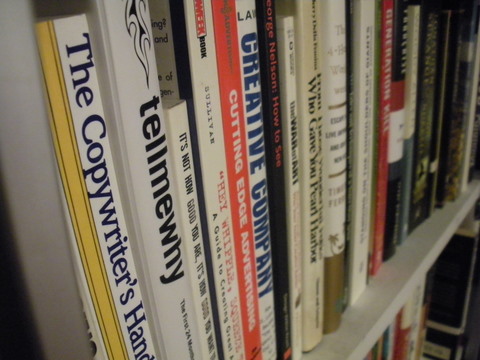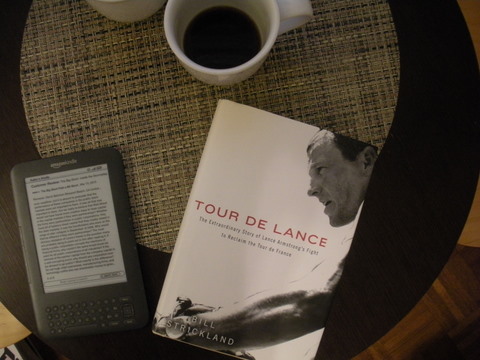The thing I miss most about taking public transport - other than the oversized handbags digging into my side or being pushed next to guys who have B.O. strong enough to kill a horse - is that there is really no safe way to read on a bicycle. I’ve thought about audio books but have noticed on the rollers that, if I’m trying to intently listen to something while on the bike, my pedaling slows and I am definitely not paying attention to the things that are going on outside the space between my ears. This means that while I’ve gotten better at maneuvering around traffic since starting cycling, my literary prowess has as much spunk as an anemic anorexic.
Enter the end of academia and the re-introduction [commencing last summer with Strickland’s Ten Points] of books into my life. You know, the fun kind that aren’t just filled with cases and case notes. Though the “reading for fun” thing tapered off when school started last fall, a month or so ago, I felt the textured pages of a book. And I was hooked again.

At first it was magazines, then books and books and more books. Picking up a habit of Mike’s, I started to stockpile books. I’ll read this one after I read that one, I thought, justifying the purchase of two books because they were used and only $8.50 a piece and hardcover, even. They took up a small corner of Mike’s apartment, waiting for me to rifle through their pages. Then, passing a bookstore the next day, I picked up a paperback because, well, hardcovers are a bit bulky to carry back and forth on a bus. I’d need something to read between Boston and New York.
All of which has conspired to persuade me that taking the T in to work might not be so bad. The precious reading time might outweigh the mere 4 miles it takes to bike to Park Street, even if that means I have to leave my apartment earlier to get jostled around in an unstable, overcrowded, absurdly slow trolley car. I was already leaning this way when I received the new Kindle as a gift. Addicted to reading a screen that actually looks like a printed page, I read more than wrote, and spent precious time I should be on the rollers, curling up with my brain’s new love.

But then within that stockpile of physical books that I had amassed earlier, I picked up one that I had started weeks ago before being interrupted by the slim sexiness that is my Kindle. And that book - Bill Strickland’s Tour de Lance - had me consciously choosing to take the T, and stuffing that large hardcover into my bag, squished between my lunch, water bottle, and change of clothes.
For those that watched the 2009 TDF, the book may not be on their short list. Having missed most of it, and only catching a stage or two here and there, the book was an awesome stage by stage of the first TDF I attempted to follow. Being surrounded by cycling enthusiasts who just know a shit ton more than I do about pro cycling [see here], it was a little intimidating trying to understand what the hell was going on last summer. My brain caught little glimpses, but never the entire picture. I still don’t really get what’s going on, and rely heavily on friends to explain who is likely to win a stage, who might win the yellow [or pink or red] jersey, and what lies in store for each stage. I ask questions until it seems to annoy, then I stop and bide my time until I feel I can ask more.
Strickland’s book was like taking a few very well informed friends and tying them to a chair and extracting information from them at gunpoint about the 2009 TDF. Actually it’s better because, though its full title is Tour De Lance: The Extraordinary Story of Lance Armstrong’s Fight to Reclaim the Tour de France, Strickland gives a glimpse into not only Armstrong’s comeback, but into the characters that make the TDF so interesting. There are the charming Schlecks, the super domestiques that carry the yellow jersey to victory, and even in the shadow of the whole “it might be doping plastic residue in his blood” thing, the shyly adorable [at least to me] Alberto Contador. And it’s these personalities that bring the 2009 TDF to life.
Armstrong’s commitment to the Livestrong cancer foundation and his stated motivation for returning to pro cycling aside [can you really argue against cancer? Can you? Really???], it seems a gross understatement to say that he is a polarizing figure. Between honest insights into Armstrong’s personality, Strickland leaves the reader to make an independent decision on whether to actually like the guy or not, which is refreshing given Armstrong’s deathlike grip on reinforcing a positive public image at nearly any cost. And even if one might end up believing that Armstrong might want to reconsider his snippy Tweeting, there’s a lot more to the book than just Armstrong. Because while to the average American, the TDF may be reduced into the image of the infamous Texan, in reality, his teammates, fellow pros, and rivals are what make the three week stage race so compelling. Cadel Evans, Jens Voigt, and Fabian Cancellara all grace the pages and the stages of the book, and while Armstrong’s athletic ability and drive are as impressive as ever, in the end, it was the wheel of Cuddles, Voigt, or FabCan that I wanted to jump onto, to hang on breathless and follow.

Part of that is due to personal bias, but [unsurprisingly, if you read Strickland’s Sitting In] it’s also due to what Strickland does best: telling the “smaller” story of the characters that are necessary for any Tour. The characters without which Armstrong’s victories would be at best, boring, and at worst, meaningless. And though it could be argued that Armstrong has forgotten this fact himself, Strickland certainly has not. Though pros like Tommy Voeckler and [American] Christian Vande Velde are admittedly limited to the sidelines of the story, Strickland manages to squeeze enough of their essence onto the pages to spark a curiosity and interest that could solidify into an addiction of pro cycling as a whole, from Paris-Roubaix to the Vuelta a Espana. Personally, Boy Racer about Mark Cavendish, In Pursuit of Glory about Bradley Wiggins, Rough Ride by Paul Kimmage, and [you saw this coming, didn’t you?] From Lance to Landis: Inside the American Doping Controversy at the Tour de France by David Walsh ended up on my short list before my eyes ate up the last few words of Tour de Lance.
Appropriately so, perhaps, because what shines in Strickland’s book isn’t so much Armstrong as the TDF itself. While that may be an unintended outcome, it actually might be the better one. Because Strickland’s book is more than enough to convert a pro peloton newbie into a true fan of the TDF, even after Armstrong stops racing.
And you know, I’m all for committed, long-term relationships.